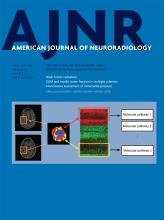Abstract
BACKGROUND AND PURPOSE: Patients with acute stroke with robust collateral flow have better clinical outcomes and may benefit from endovascular treatment throughout an extended time window. Using a multiparametric approach, we aimed to identify MR perfusion parameters that can represent the extent of collaterals, approximating DSA.
MATERIALS AND METHODS: Patients with anterior circulation proximal arterial occlusion who had baseline MR perfusion and DSA were evaluated. The volume of arterial tissue delay (ATD) at thresholds of 2–6 seconds (ATD2–6 seconds) and >6 seconds (ATD>6 seconds) in addition to corresponding values of normalized CBV and CBF was calculated using VOI analysis. The association of MR perfusion parameters and the status of collaterals on DSA were assessed by multivariate analyses. Receiver operating characteristic analysis was performed.
RESULTS: Of 108 patients reviewed, 39 met our inclusion criteria. On DSA, 22/39 (56%) patients had good collaterals. Patients with good collaterals had significantly smaller baseline and final infarct volumes, smaller volumes of severe hypoperfusion (ATD>6 seconds), larger volumes of moderate hypoperfusion (ATD2–6 seconds), and higher relative CBF and relative CBV values than patients with insufficient collaterals. Combining the 2 parameters into a Perfusion Collateral Index (volume of ATD2–6 seconds × relative CBV2–6 seconds) yielded the highest accuracy for predicting collateral status: At a threshold of 61.7, this index identified 15/17 (88%) patients with insufficient collaterals and 22/22 (100%) patients with good collaterals, for an overall accuracy of 94.1%.
CONCLUSIONS: The Perfusion Collateral Index can predict the baseline collateral status with 94% diagnostic accuracy compared with DSA.
ABBREVIATIONS:
- ASITN
- American Society of Interventional and Therapeutic Neuroradiology
- ATD
- arterial tissue delay
- PCI
- Perfusion Collateral Index
- rCBF
- relative cerebral blood flow
- rCBV
- relative cerebral blood volume
- ROC
- receiver operating characteristic
- Tmax
- time-to-maximum
- © 2018 by American Journal of Neuroradiology
Indicates open access to non-subscribers at www.ajnr.org












